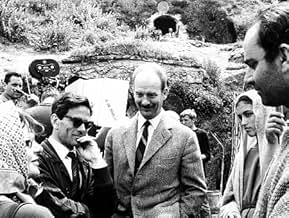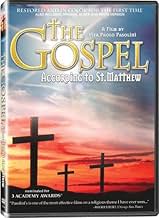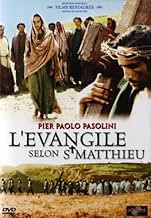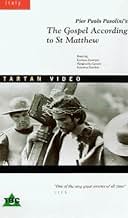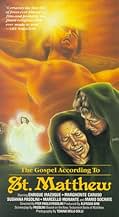A vida de Jesus Cristo segundo o Evangelho de Mateus. Pasolini apresenta Cristo como uma vanguarda marxista e, por isso, usa parte do texto de Mateus.A vida de Jesus Cristo segundo o Evangelho de Mateus. Pasolini apresenta Cristo como uma vanguarda marxista e, por isso, usa parte do texto de Mateus.A vida de Jesus Cristo segundo o Evangelho de Mateus. Pasolini apresenta Cristo como uma vanguarda marxista e, por isso, usa parte do texto de Mateus.
- Direção
- Roteirista
- Artistas
- Indicado a 3 Oscars
- 7 vitórias e 9 indicações no total
- Caifa
- (as Rodolfo Wilcock)
Avaliações em destaque
First - it contains perhaps the most powerful piece of MUSIC I ever experienced in a movie. I've never forgotten my utmost impression from that music when I saw the movie for the first time in a film-club some twenty-five years ago. From a total silence of the first titles, a music like an avalanche of a heavenly army hitting the soul ...
Which music it was? MISA LUBA! An incredible polyrithmic blend of three ingredients: a high melodic church chorus of Kenyan women, plus an unbelievably improvising african singer, plus a bunch of African drummers... everything locked together by an unrepeatable moment of inspiration and chance. I could not imagine some most powerful music to underline the most exposed passages of Jesus' story. Curiously and sadly enough, this MISA LUBA is even not credited in the movie titles, in contrast to a fair (but much more standard) classic music used in most of the movie. It was just this happy usage of MISA LUBA which contributes most to the soul and mood of the Pasolini film. It is also well understandable why Pasolini used an eclectic mixture of music from various continents, -- in an obvious intention to make the universal story yet more UNIVERSAL, across the nations and cultures.
Second happy aspect of Pasolini's interpretation is his cast of characters, his choice of believable and interesting types ... for Jesus, for Maria, and most other characters. These are believable and convincing types of people from the middle-east. How superior and fair is here Pasolini in comparison with all those funny blue-eyed and polished Hollywood casts of those pseudo-biblic stories ...
And third - Pasolini did very well to make the movie in black-and-white. It contributes to a mystical, spiritual and abstract atmosphere of the opus. In my opinion, it would be hardly possible to make this movie well in color.
And yes, I agree with those who say that practically all other movies about Jesus and those biblic stories are fundamentally wrong, and in cases of those (in)famous Hollywood versions - even funny to tears.
This Pasolini's opus is very honest and might be the 'very best film interpretation of Jesus' story.
This is such a stately, respectful, yet contemporary (and dare I say, Italian) production, in quiet black and white, it's hard to find fault with it. In some ways, I think it does exactly what it intends. It mixes long shots with close ups. It moves with clarity and sharp (no dissolve) cuts from face to face. It uses African-American gospel and Bach. It depends on solemnity, and it uses actors that have the faces, and demeanors, to be utterly solemn and strong.
All the actors are amateurs. Pasolini was an atheist. The triumph at the end is a matter of record. It's all here.
The question might be (for some) whether it is nevertheless a movie you want to watch. And I say, absolutely. You do have to like, or learn to like, movies that are about quiet ambiance, about passive expressions that say more than intense extroverted acting. The black and white photography, something of a throwback during this early 1960s production, gives it even more of the timeless, almost melancholy depth that keeps it going, owing something to the Dreyer's Joan of Arc, I think.
It's important to know this is not really an interpretation of the gospel, but a reading of it. The filming of course required actors, but it tries to be factually straight forward. That's incredibly hard to pull off without arrogance or religiosity. But Pasolini does it. The down side to this is that it's slow, or even (no sacrilege here), boring. I mean, I read the book.
For me, what makes it terrific is not only how it is filmed (the camera-work and editing) and the faces (all those faces, with the camera still and focused on them), but the sense of reality here. The holiness is removed, but not the sacred seriousness. It makes it seem possible in a very real way. The people, the places, all of it is not historic, not in particular, but the effect, the mood, the force of it all is profound. Even for a non-believer. It's quite something to get swept into.
Pasolini's Biblical adaptation of the Gospel of Matthew far surpasses present day movies of this genre in its overall effect on the viewer. The real substance of the film, the story of Jesus, is not glossed over with big budget extras, professional actors, and special effects which only seem to overshadow the awe inspiring wisdom of the words spoken by Jesus in the New Testament.
The fact that the actors are of Mediterranean decent only serves to make the film more believable. The costumes and settings appear to be more realistic than the Hollywood versions that I have seen in other Biblical films. The Jewish Church leaders with their alien looking hats show how detached and imposing these figures must have appeared to the common people of the time of Jesus. When Jesus threatens their positions of power by bringing God directly to the people without need of a temple or an interpreter it sheds light on how these leaders felt threatened by a "poor son of a carpenter".
Most films of this genre focus more on the Romans oppression of Jesus without showing the betrayal by the Jewish leaders that led to the unjust crucifixion of Jesus.
I highly recommend this film to anyone who has become bored with seeing the story of Jesus on film. If you think that you have seen it all and do not want to sit through yet another trumped up version of the story of Jesus then I suggest that you view this movie, for it succeeds where all others have failed.
Você sabia?
- CuriosidadesPier Paolo Pasolini used non-professional actors and cast local peasants, shopkeepers, factory workers, and truck drivers. For Mary at the time of the Crucifixion, he cast his own mother Susanna Pasolini.
- Erros de gravaçãoWhen they are taking Christ down from the cross, in the distance you can see a car driving around a corner.
- Citações
[last lines]
Christ: All authority has been given to me in heaven and earth. Go, therefore. And make disciples of all nations, baptizing them in the name of the Father, and of the Son and the Holy Ghost, teaching them to observe everything I have commanded you. And behold. I am with you always even unto the end of the world.
- Versões alternativasThe 2007 DVD release features a colorized, English-dubbed version with a run time of 91 minutes and an Italian-language black and white version running 136 minutes.
- ConexõesEdited into Histoire(s) du cinéma: Une histoire seule (1989)
- Trilhas sonorasMatthäus Passion (BWV 244)
Written by Johann Sebastian Bach
nr 78: Wir setzen uns mit Tränen nieder
nr 47: Erbarme Dich (musical intro)
Principais escolhas
- How long is The Gospel According to St. Matthew?Fornecido pela Alexa
Detalhes
- Data de lançamento
- Países de origem
- Idioma
- Também conhecido como
- El Evangelio según san Mateo
- Locações de filme
- Castel Lagopesole, Avigliano, Basilicata, Itália(Sanhedrin trial of Jesus, in castle's courtyard)
- Empresas de produção
- Consulte mais créditos da empresa na IMDbPro
Bilheteria
- Faturamento bruto mundial
- US$ 16.572
- Tempo de duração2 horas 17 minutos
- Cor
- Mixagem de som
- Proporção
- 1.85 : 1
Contribua para esta página



